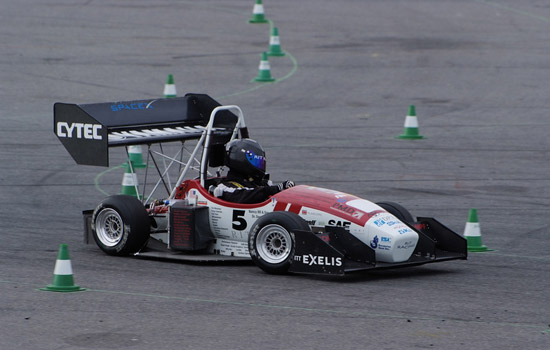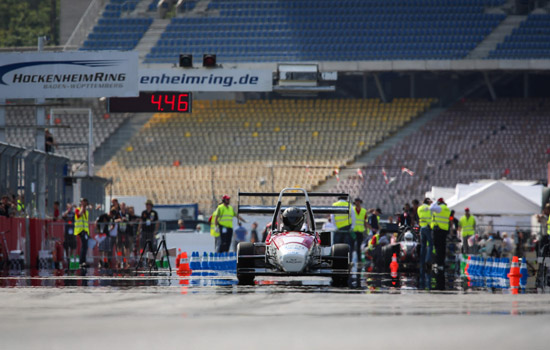Racing in top 5 in Formula Student Germany
Team places fifth overall in international competition for third year in a row
Provided by Formula Student Germany
Driver Aaron League prepares to take the green flag for the acceleration event, one of several challenges as part of the Formula Student Germany competition.
They saved the best for last.
Despite opening the 2012 season with technical and mechanical challenges, RIT Formula Racing capped its season in Europe at the Formula Student Germany competition, winning the demanding endurance event and placing fifth overall among 78 international racing teams Aug. 2-5 at Hockenheinring.
Four points and five seconds were all that separated the RIT racecar from its closest competitor, the University of Stuttgart (Germany) in the endurance finale. But it was enough to place RIT Racing among some of the top collegiate design teams in the world, and it was the third year in a row the team made the top-five in the international competition.
Teams race 22 kilometers, nearly 14 miles, in the endurance event, a timed course challenge, where drivers must negotiate multiple hairpin turns, straight-aways at high speeds and other racecars on the track. Of the 77 teams that qualified, only 39 finished.
RIT had top placements in separate events, but it was the design presentation, the team’s strength this year, and the all-important endurance run consisting of nearly 40 percent of the final point total that made the difference. RIT Racing placed second in fuel efficiency, ninth in autocross, 10th in design and in the top 20 for skid pad and its business plan. Overall, there was only a 43 point difference between RIT and the first-place winner.
“We are extremely proud of our car’s performance during endurance. The drivers were able to push the car to the limit and drive the car exactly how we designed it—to corner hard and fast, while sipping fuel,” says Brian Guenther, RIT Formula project manager and a fifth-year mechanical engineering major. “It’s been a challenging year for everyone, and it was a great feeling seeing our car put down the fastest laps of the day. In a way, it validated our entire year and proved that our design produced the fastest car on the track.”
Trouble with the differential mounting and the carbon-fiber chassis early in the season kept the team from top placements in competitions in Michigan in May and Nebraska in June. But the group never lost confidence in its sleek, new design and enhanced engine features, placing first in the presentation event and seventh out of 100 teams in the design event at Michigan, and then placing ninth in the same category in Nebraska.
“We built the 2012 car to be completely different than any car we’ve built before,” Guenther says. He and the car designers wrote a lap-time simulator to evaluate and compare different types of car designs. The results emphasized the importance of cornering ability rather than accelerating ability. “A fuel-efficient and light-weight car that could corner well would be faster than a heavier car with a more powerful engine that could accelerate faster.”
Switching from 13-inch diameter wheels to 10-inch wheels saved weight in the suspension. Building the chassis out of carbon fiber saved additional weight. Changing from a four-cylinder motorcycle engine to a single-cylinder dirt-bike engine cut 50 pounds from the engine package, Guenther explains, reducing the car weight from 450 pounds to 320 pounds. The new engine uses less fuel than previous engines and an aerodynamics package consisting of a diffuser, front wing and rear wing, similar to professional Formula 1 cars, produced extra down-force that gives the tires more grip.
“The car has really lived up to its design,” Guenther says.
RIT Racing closes its season on Oct. 7 competing in the Toronto Shootout, an invitational meet at the Canadian Tire Motorsport Park and hosted by the University of Toronto.
 Driver Taylor Hattori maneuvers around cones, turns and straight-aways on the endurance course, a timed course challenge that RIT Racing won.
Provided by Brian Guenther
Driver Taylor Hattori maneuvers around cones, turns and straight-aways on the endurance course, a timed course challenge that RIT Racing won.
Provided by Brian Guenther














